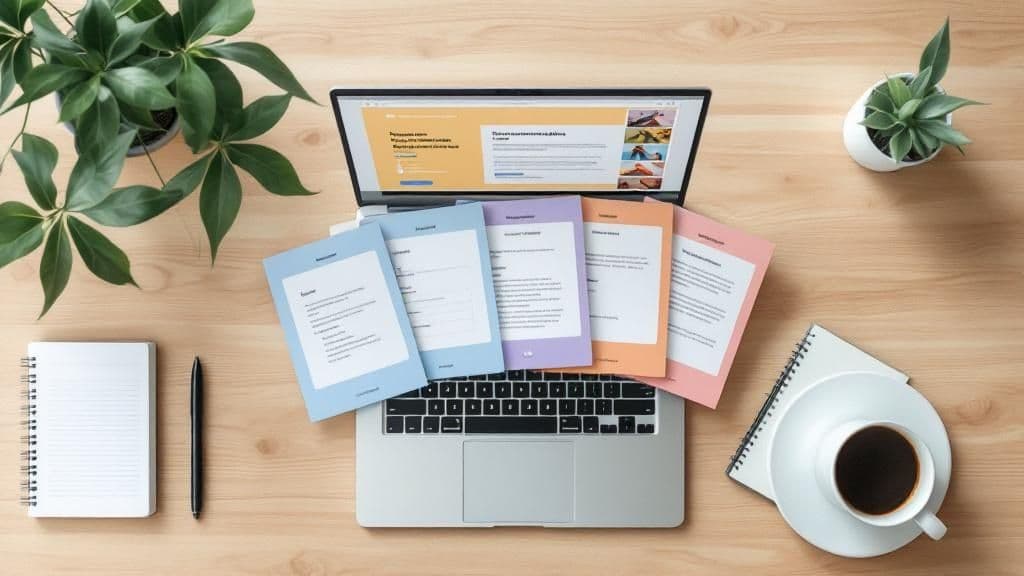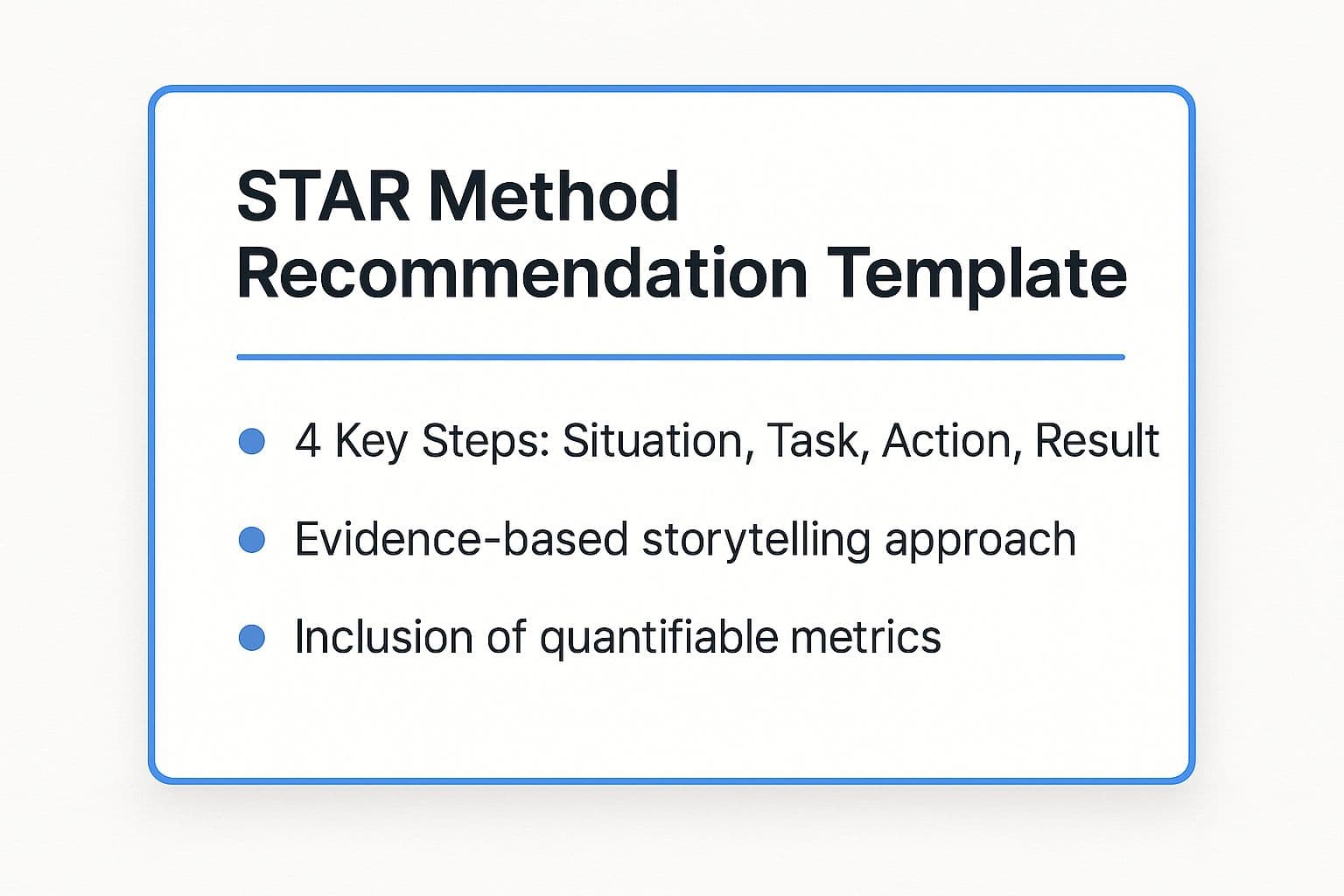Best Template for Recommendations: Top 6 Easy-to-Use Guides
Discover the best template for recommendations with our top 6 easy-to-use guides. Enhance your suggestions today and impress your audience!

Writing a recommendation letter sounds simple until you actually sit down to do it. That blinking cursor on a blank page can feel surprisingly intimidating. How do you sound professional but not robotic? How do you genuinely highlight someone's best qualities without just listing a bunch of generic adjectives? It’s a common struggle that can quickly turn a simple favor into a time-consuming task. You want to do right by the person you're recommending, but crafting the perfect message from scratch takes real effort and mental energy.
This guide is your shortcut. We've gathered six proven, easy-to-use templates for recommendations, each designed for a specific, common scenario. Whether you're helping a former colleague land a dream job, supporting a student's scholarship application, or endorsing a connection on LinkedIn, we have a framework for you. If you're still struggling to begin, a testimonial generator tool can offer a great starting point for crafting compelling recommendations by providing structured inspiration.
Forget the guesswork and the stress. This list is all about providing a clear template for recommendations that you can adapt and use immediately. Let's get you writing with confidence and get that letter done.
1. STAR Method Recommendation Template
Kicking off our list is less of a copy-paste solution and more of a powerful framework: the STAR Method Recommendation Template. If you've ever struggled to make a recommendation sound impactful instead of just a list of generic praises, this is the approach for you. Popularized by HR professionals and business schools, the STAR method forces you to tell a compelling story backed by real-world evidence.
The acronym stands for Situation, Task, Action, Result. It’s a structured storytelling technique that moves beyond vague statements like "she's a great leader" and instead provides concrete proof. You set the scene (Situation), describe the person's objective (Task), detail what they specifically did (Action), and then, most importantly, explain the tangible outcome (Result). This structure is the secret sauce for a recommendation letter that actually gets read and remembered.
Why This Framework Is a Game-Changer
Using this template for recommendations transforms your letter from a simple endorsement into a compelling case study. Instead of just listing skills, you're demonstrating them in action. This is incredibly effective for MBA program applications, where demonstrating leadership is key, or for job applications where recruiters want to see proof of past performance.
For example, when recommending a former team member for a project manager role, you could use STAR to describe a time they salvaged a failing project.
- Situation: The team was behind schedule on a critical software launch.
- Task: The candidate was tasked with getting the project back on track without extending the deadline.
- Action: They re-prioritized the backlog, implemented daily stand-up meetings for better communication, and automated a key testing process.
- Result: The project was delivered on time, leading to a 15% increase in customer satisfaction scores for that quarter.
This single, detailed example is far more persuasive than a paragraph of general praise. The specificity makes the candidate's skills feel real and measurable.
Key Takeaways for the STAR Method
To help you visualize how this method breaks down, this summary box highlights its core components.

The infographic reinforces that the STAR method is all about building a narrative around quantifiable evidence. The real power lies in connecting specific actions to measurable results, which makes your recommendation stand out. It's a proven formula for demonstrating competence, not just claiming it.
2. Academic Reference Letter Template
Next up is a highly structured yet essential resource: the Academic Reference Letter Template. While less of a narrative framework like STAR, this template provides the formal structure and specific content pillars required to succeed in academic settings. It's designed for professors, research supervisors, and mentors writing for students applying to graduate school, research positions, or academic fellowships. The goal is to present a candidate's scholarly potential in a way that admissions committees and hiring panels expect and respect.
This formal template for recommendations guides you to include critical details like specific coursework, grades, and class rank, which are crucial data points in academia. It emphasizes a student's research capabilities, critical thinking skills, and intellectual curiosity, all while maintaining a professional, authoritative tone. Think of it as the standard operating procedure for academic endorsements, popularized by university career services and graduate school admissions committees for its clarity and effectiveness.

Why This Template Is Essential for Academia
Using this template ensures your letter meets the high standards of academic review. Admissions committees sift through hundreds of applications; a letter that is poorly structured or missing key information can inadvertently harm a brilliant candidate's chances. This template prevents that by organizing your praise into a logical, evidence-based format that speaks the language of academia.
For instance, when recommending a student for a Ph.D. program in biology, you would use this structure to move beyond simple praise.
- Opening: Clearly state your relationship to the student, the capacity in which you know them, and for how long.
- Academic Performance: Detail their exceptional performance in a specific advanced course, like "Molecular Genetics," mentioning their final grade (A+) and class rank (top 5%).
- Research & Contributions: Describe their specific role in your lab, highlighting a unique contribution they made, such as optimizing a PCR protocol that improved data accuracy.
- Comparison & Potential: Compare the student favorably to previous students you've taught who have gone on to successful graduate careers, reinforcing their potential.
This structured approach makes your endorsement credible and easy for a review committee to digest. It directly answers the questions they have about a candidate's readiness for rigorous academic work.
Key Takeaways for Academic Letters
For those crafting academic reference letters or scholarship recommendations, general writing tips for students can significantly enhance your letter's quality. To make the most of this template, remember to incorporate discipline-specific language and be honest but constructive about any perceived weaknesses. The best academic letters are detailed, comparative, and grounded in concrete evidence of a student's intellectual horsepower and scholarly promise. They demonstrate that you know the candidate well and can confidently vouch for their future success. To further refine your professional correspondence, you can improve your English communication skills with Typeboost.
3. Professional Reference Template
Next up is a highly structured and business-centric approach: the Professional Reference Template. This is your go-to format when the stakes are high, such as for a job application, an internal promotion, or a nomination for a competitive leadership program. It moves beyond storytelling frameworks and adopts the formal tone and structure favored by corporate HR departments and executive search firms.
The core idea of this template for recommendations is to present a candidate's qualifications in a way that directly aligns with business objectives. It emphasizes workplace competencies, quantifiable achievements, and leadership potential. Unlike more personal or academic letters, this style is laser-focused on professional impact and future value to an organization, making it exceptionally persuasive in a corporate context.
Why This Framework Is a Game-Changer
This template provides a clear, professional blueprint that ensures you cover all the essential bases for a corporate audience. It’s designed to answer the questions a hiring manager or executive committee is already asking: Can this person do the job? Can they lead? And can they grow with our company? The structure is less about a single narrative and more about building a comprehensive professional profile.
For instance, when endorsing a colleague for an internal promotion to a management role, you would structure your letter to hit specific points:
- Relationship and Context: "I was Sarah's direct supervisor for three years in the marketing department."
- Quantifiable Achievements: "Under her leadership, the digital marketing team increased lead generation by 40% and reduced cost-per-acquisition by 25%."
- Leadership and Teamwork: "She excels at mentoring junior team members and fostered a collaborative environment that improved cross-departmental project outcomes."
- Future Potential: "Given her strategic mindset and proven results, I am confident she possesses the skills necessary to excel as a Marketing Director."
This approach systematically builds a case for the candidate, leaving no doubt about their suitability. You can discover more about how to structure these formal letters and find the right words on TypeBoost's blog about AI letter writing.
Key Takeaways for the Professional Reference Template
To make sure your professional recommendation hits the mark, focus on these critical components. They transform a standard reference into a powerful endorsement that speaks the language of business leaders.
- Emphasize Metrics: Always include specific numbers like revenue growth, cost savings, or efficiency improvements.
- Highlight Leadership: Discuss their ability to manage teams, mentor others, and drive initiatives.
- Address Team Dynamics: Mention how they collaborate and contribute to a positive team culture.
- Connect to Future Growth: Conclude by confidently stating their potential for future success in the new role.
This framework is the gold standard for any formal business recommendation, ensuring your endorsement is taken seriously and carries maximum weight.
4. Character Reference Template
Moving away from professional achievements, we arrive at a template for recommendations that focuses on something much more personal: character. The Character Reference Template is designed to speak to an individual’s integrity, ethics, and personal qualities rather than their job skills. If you've been asked to vouch for someone's moral standing for a court case, volunteer position, or immigration hearing, this is the framework you need.
This type of recommendation hinges on credibility and sincerity. It’s less about metrics and more about human qualities like honesty, reliability, and compassion. Popularized by legal professionals and community organizations, this template helps you structure a statement that is both personal and authoritative. You are essentially testifying to someone's good nature, so the structure needs to convey trust and provide concrete, observable evidence of their character.
Why This Framework Is a Game-Changer
A well-written character reference can be the deciding factor in high-stakes personal situations. It provides a crucial third-party perspective on who a person is, separate from their resume or official records. This is invaluable for legal proceedings, adoption cases, or applications to community-focused roles where trustworthiness is the most important qualification.
For instance, when writing a character reference for a friend’s custody case, you need to go beyond saying "they are a good parent." Instead, you can provide specific anecdotes that demonstrate their character in action.
- Describe the nature and length of your relationship to establish credibility (e.g., "I have known Sarah for over 15 years as a close friend and neighbor").
- Provide a specific example of their integrity (e.g., "I witnessed her find a wallet full of cash and spend two hours tracking down the owner to return it").
- Showcase their consistency over time (e.g., "This dedication to doing the right thing is something I have seen consistently in her actions throughout our friendship").
This approach transforms a generic endorsement into a powerful testament. The specific, story-based evidence makes the person's positive qualities tangible and believable to a judge, a board, or an immigration officer.
Key Takeaways for the Character Reference
This summary box highlights the core components needed to craft a persuasive character reference that truly makes an impact.
The infographic reinforces that a strong character reference is built on a foundation of a long-standing relationship and illustrated with specific, real-world examples of ethical behavior. The goal is to paint a picture of consistent moral integrity, making it a critical tool in situations where a person's character is under direct scrutiny.
5. Scholarship Recommendation Template
Next up is a highly specialized framework: the Scholarship Recommendation Template. Writing a recommendation for a scholarship is a different beast entirely. It’s not just about professional skills or academic grades; it’s about painting a holistic picture of a candidate who is not only deserving but also aligns with the scholarship's specific mission. This template for recommendations helps you balance academic merit, personal character, and future potential.

This approach, championed by university financial aid offices and high school guidance counselors, provides a structure for hitting all the key points that scholarship committees look for. It moves beyond a simple transcript summary to tell a story about the student's drive, resilience, and commitment. Whether it's for a merit-based award, a need-based grant, or a community service scholarship, this template ensures you cover all the essential bases.
Why This Framework Is a Game-Changer
A generic letter won't cut it when financial awards are on the line. This template forces the recommender to connect the applicant's past achievements and future aspirations directly to the scholarship's goals. It’s about demonstrating worthiness on multiple levels, from academic excellence to personal integrity and, often, financial need.
For instance, when recommending a student for a community service scholarship, you can structure your letter to highlight specific contributions.
- Academic Excellence: Start by confirming their strong academic standing to establish credibility.
- Character and Drive: Share an anecdote that showcases their dedication, perhaps how they balanced studies with volunteering.
- Community Impact: Detail their role in a specific volunteer project, quantifying their impact where possible (e.g., "organized a food drive that collected 500 pounds of non-perishables").
- Future Potential: Connect their past service to their future goals, explaining how the scholarship will enable them to continue making a difference.
This multi-faceted approach provides the committee with a complete and compelling narrative, making it clear why this specific student is the ideal recipient for their award.
Key Takeaways for Scholarship Recommendations
To effectively use this template, tailoring your content is crucial. This summary box outlines the essential elements to focus on.
The core idea is to address the unique criteria of each scholarship. Unlike a job recommendation that focuses on skills, a scholarship letter must speak to the applicant’s character, circumstances, and alignment with the granting organization’s values. It’s a powerful tool for turning a good student into an undeniable candidate.
6. LinkedIn Recommendation Template
Next on our list is a template for recommendations specifically tailored for the fast-paced, digital world of professional networking: the LinkedIn Recommendation Template. While a formal letter has its place, a recommendation on LinkedIn is a public-facing testimonial that lives permanently on a person's profile. This template is designed for impact and conciseness, perfect for the platform's scannable nature.
The core idea is to deliver a powerful endorsement that is both personal and professional, highlighting a person's key skills within the context of your working relationship. Unlike a private letter, this recommendation is for a broad audience of recruiters, potential clients, and industry peers. It needs to be sharp, keyword-rich, and get straight to the point. It’s less about telling a long story and more about providing a strong, credible soundbite that reinforces a person's personal brand.
Why This Framework Is a Game-Changer
Using a dedicated template for LinkedIn recommendations ensures your endorsement is optimized for the platform. It helps you avoid generic phrases like "John was great to work with" and instead offer specific praise that boosts the recipient's professional credibility. This approach is invaluable for former colleagues, managers endorsing direct reports, or even freelancers showcasing client testimonials.
A well-crafted LinkedIn recommendation acts as powerful social proof. For instance, when recommending a freelance designer you hired for a project, you could write:
- Opening: "I had the pleasure of collaborating with Sarah on a complete rebranding project for our SaaS startup." (Establishes the relationship and context).
- Specific Skills: "Her expertise in UI/UX design was immediately apparent. She took our initial vague concepts and transformed them into a sleek, intuitive interface that our users love." (Highlights key strengths).
- Impact/Result: "Thanks to her work, we saw a 20% reduction in user bounce rate within the first month of launching the new design." (Provides a tangible outcome).
- Closing: "Any team would be lucky to have Sarah. I confidently recommend her for any design-related role and look forward to working with her again." (Offers a strong, forward-looking endorsement).
This structure is concise yet packed with value, making it far more effective than a simple thumbs-up. It gives future viewers of the profile concrete reasons to trust the person's abilities. For more insights on crafting compelling professional content, check out these LinkedIn post writing tips on typeboost.ai.
Key Takeaways for the LinkedIn Recommendation
To help you craft the perfect digital endorsement, this summary box highlights the essential components.
The infographic emphasizes that a great LinkedIn recommendation is a blend of personal connection and professional evidence. The goal is to create a concise, impactful statement that strengthens the recipient's profile by using specific examples, relevant keywords, and a clear statement of your professional relationship. It’s a small effort that can make a huge difference in someone’s career visibility.
Comparison of 6 Recommendation Templates
| Template | Core Features / Characteristics | User Experience / Quality Metrics | Value Proposition | Target Audience 👥 | Unique Selling Points ✨ | Price Point / Rating |
|---|---|---|---|---|---|---|
| STAR Method Recommendation | 4-step structure: Situation, Task, Action, Result | ★★★★ Highly credible, evidence-based | Persuasive, concrete examples | Professionals, Academics, MBA Programs | Quantifiable metrics, real-world proof 🏆 | Free / widely used |
| Academic Reference Letter | Formal academic tone, research focus, peer comparison | ★★★★ Formal, thorough, scholarly recognized | Tailored to academic standards | Graduate schools, researchers, educators | Emphasizes research & academic potential ✨ | Free / institutional |
| Professional Reference | Business format, leadership, workplace skills | ★★★★ Practical, measurable business impact | Relevant for hiring & promotions | Employers, HR, Corporate professionals | Industry-specific metrics & growth focus ✨ | Free / customizable |
| Character Reference | Focus on personal qualities, integrity, trustworthiness | ★★★ Good for personal credibility | Unique character insights | Legal, volunteer orgs, community groups | Emotional and ethical behavior examples ✨ | Free / informal |
| Scholarship Recommendation | Mix of academic, personal circumstances, financial need | ★★★★ Balanced & targeted application support | Addresses scholarship-specific criteria | Students, scholarship committees | Combines merit & personal story factors ✨ | Free / academic |
| LinkedIn Recommendation | Concise, online optimized, skills & outcome driven | ★★★ Easy to write, visible, network-enhancing | Boosts online professional presence | Networkers, job seekers, professionals | LinkedIn integration & keyword focus ✨ | Free / platform-dependent |
From Template to Triumph: Your Next Steps
We’ve journeyed through a comprehensive toolkit, exploring a template for recommendations for nearly every personal and professional situation you can imagine. From the structured STAR method for corporate endorsements to the heartfelt narrative of a character reference, these frameworks provide a massive head start. They eliminate the blank-page anxiety and ensure you hit all the critical points.
The core takeaway is simple: a great template is a starting point, not a final destination. Its true power is unlocked when you personalize it. The most impactful recommendations are those that blend a solid structure with genuine, specific, and enthusiastic details. Think of it as building a house: the template is your blueprint, but the stories, anecdotes, and specific examples are the materials that make it a home.
Moving from Structure to Story
So, where do you go from here? The next step is to put this knowledge into practice. Don't just save these templates; use them as a launchpad for your next recommendation letter.
Here’s your action plan:
- Identify Your Purpose: Before you even select a template, get crystal clear on the goal. Is it for a job? A scholarship? A LinkedIn profile? Each context demands a slightly different angle and tone.
- Brainstorm the Specifics: Ditch the generic praise. Jot down 2-3 concrete examples that showcase the person's skills, character, or achievements. Did they lead a project that boosted revenue? Did they show incredible resilience during a tough time? These are the details that bring a recommendation to life.
- Customize, Don't Copy-Paste: Use the chosen
template for recommendationsto structure your thoughts. Fill in the blanks with your brainstormed specifics, and then refine the language to match your own voice. The goal is for the letter to sound like it came from you, not a robot.
Mastering this process does more than just help you write a good letter; it strengthens your professional relationships and builds your reputation as a thoughtful, reliable, and supportive colleague or mentor. Your endorsement can be the final piece that helps someone land their dream job or secure a life-changing opportunity.
And remember, a strong recommendation is often part of a larger application package. Once your letter is polished, the candidate will need to ensure the rest of their documents are equally compelling. To help them build a cohesive and professional application, you can explore additional resources like these CV template resources to refine their entire submission. Your powerful words, combined with a stellar resume, can make all the difference.
Ultimately, the art of the recommendation lies in authenticity. Take these templates, infuse them with your unique perspective and sincere support, and you won't just be writing a letter; you'll be championing someone's success.
Ready to make every recommendation, email, and client-facing document shine without constantly switching apps? TypeBoost integrates directly into your existing workflow, allowing you to access powerful AI writing assistance, custom templates, and tone adjustments right where you type. Supercharge your writing and reclaim your flow with TypeBoost today.